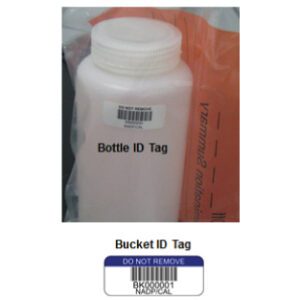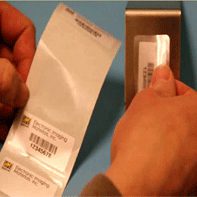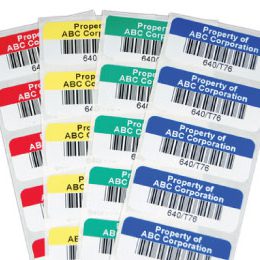Here’s the truth: most microscope slide labels aren’t built for real lab conditions. They fade, fall off, or smear the second they meet a little heat or solvent. And yet, labs still use them, until it costs time, samples, or worse, compliance. If your slide labels can’t survive the way your specimens are handled, you’re due for an upgrade. Let’s break down what it really takes for a label to endure extreme lab environments, and how to make sure yours does.

Why Slide Labels Fail in Harsh Lab Environments
You’re asking a lot of your labels, and for good reason. Slide labels need to stay perfectly intact and readable as they go from cryogenic storage to 60°C ovens, then through baths of alcohol or xylene. Most generic labels simply weren’t designed for that kind of punishment.
Labels often fail due to one or more of the following:
- Peeling or curling during freeze-thaw cycles
- Smudging or fading after exposure to alcohol or xylene
- Edge lifting under high heat or steam sterilization
- Adhesive breakdown in low temperatures or high humidity
Each of these failures puts sample tracking, compliance, and lab productivity at risk. That’s why choosing the right slide labels isn’t just about materials; it’s about durability through every phase of your workflow.
Heat-Resistant Labels: Built for the Burn
Slide labels frequently pass through heating elements like ovens, dry incubators, or autoclaves. If the label material or adhesive isn’t engineered for these high-heat environments, the consequences aren’t subtle. Sometimes, you’ll see cracking, fading, or full label detachment mid-process.
Even brief exposure to elevated temperatures can weaken the adhesive or damage the print surface. Traditional materials simply can’t keep up in labs where slides cycle between heating and cooling stages.
What Heat Challenges Look Like
In many labs, slides are subjected to:
- Sustained exposure to 60°C+ environments
- Steam sterilization (autoclave cycles)
- Temporary heat from sunlight or transport conditions
- Incubation stages that gradually raise internal temperatures
These aren’t occasional events—they’re routine in histology, pathology, and research labs. Without the right materials, you’re asking your labels to do the impossible.
What Survives
- Polyester or polyimide facestocks that resist warping, curling, and brittleness
- Permanent adhesives that retain their bond despite repeated heating
- Heat-resistant topcoats that maintain print clarity and resist discoloration through drying or sterilization
These materials work together to preserve legibility, adhesion, and barcode scannability, even in harsh thermal environments. If your workflow includes any heating stage—from short-term warming to full-on autoclaving—you need labels built for the burn, not just to look good on paper.
Labels and Solvents: A Smudge-Proof Strategy
Solvents like alcohol and xylene are daily staples in histology and pathology workflows, but for labels, they’re among the most destructive elements a slide will encounter. The right label must endure brief splashes, full immersion, and repeated handling while maintaining clear print and strong adhesion.
Why Solvents Are So Problematic
Slide labels exposed to solvents often suffer from:
- Smudged or blurred print under wet handling
- Adhesive degradation in staining baths or rinse stages
- Labels sliding off during alcohol-based cleaning or disinfectant wipe-downs
These aren’t isolated incidents. They’re systemic issues that can derail tracking and introduce compliance risk.
Your Defense Against Solvent Damage
To combat these issues, your labels should include:
- Synthetic facestocks (like polyester) that resist solvent absorption and won’t swell or degrade
- Thermal transfer or UV inkjet topcoats that lock in barcode data and resist smearing—even when submerged
- Aggressive adhesives that remain bonded to the slide, even in xylene or ethanol environments
Solvent resistance is not a luxury. It’s a requirement in modern labs. When selecting slide labels, ensure they’re built to handle full immersion or repeated contact with harsh cleaning agents. Labels that combine solvent resistance with heat tolerance and cryo stability deliver the highest reliability and the lowest rework rate in your entire workflow.
Cryogenic Labels: Holding Up in the Cold
Cryogenic storage pushes labels to the absolute limit. Freezers, liquid nitrogen tanks, and repeated freeze-thaw cycles subject labels to harsh, brittle conditions that test even the most durable materials. Standard slide labels may crack, curl, or fall off altogether, taking crucial sample data with them.
When labels fail under these conditions, it’s frustrating and dangerous for your workflow. A missing label in cryo storage means a lost sample, a missed traceability checkpoint, and potentially compromised research or diagnostics.
Cryo-Critical Conditions
Cryogenic labels must be engineered to survive:
- Storage in freezers at -20°C to -80°C or colder
- Rapid transitions between room temperature and ultra-cold storage
- Surface frost, condensation, and ice can weaken adhesion
What Freezer-Safe Lab Labels Need
Not all labels are created equal. The best freezer-safe lab labels feature:
- Cryogenic adhesives that create a permanent bond even in sub-zero environments
- Durable facestocks (like flexible synthetics) that resist cracking and remain readable through cycles of freezing and thawing
- Moisture-tolerant application, ensuring strong adhesion even with light frost or humidity
If your labels peel, flake, or fail after time in the deep freeze, they’re not cryo-compatible. Only true cryogenic labels keep your slide data intact through the harshest conditions in your lab.
If your current slide labels cannot withstand solvents, heat, or freezing, it’s time to reassess. Electronic Imaging Materials (EIM) offers sample kits of tested, lab-tough labels made specifically for microscope slides. We’ll help you find the right solution that sticks—literally.
Slide Label Selection: Matching Labels to Your Workflow
Choosing the right slide labels isn’t a one-size-fits-all situation. Every lab has unique challenges based on the types of specimens processed, equipment used, environmental conditions, and regulatory pressures. A label that performs flawlessly in one setting might fail completely in another.
Instead of defaulting to a generic option, assess how your labels hold up throughout your actual workflow. Are they exposed to multiple freezing cycles? Do they need to withstand repeated xylene soaks or high-heat drying? Each condition demands specific material and adhesive performance.
Ask yourself:
- Do our labels peel or detach during freeze-thaw cycles?
- Are we seeing smudging or fading after alcohol or xylene exposure?
- Do autoclaves or ovens cause label edges to lift, curl, or discolor?
- Are our barcodes still sharp, scannable, and intact after the full process?
If any of these are happening, you’re not just dealing with minor inconveniences—you’re risking sample loss, noncompliance, and workflow disruption. Labels that don’t survive every step of the process become a liability.
The right labels—whether freezer-safe lab labels, cryogenic labels, or heat-resistant labels—should feel invisible in your process. They stay readable, scannable, and bonded from preparation to archiving, protecting your samples and your workflow from the first touch to the final test.
EIM Labels Are Built for the Toughest Lab Conditions
Electronic Imaging Materials builds labels that hold up in the real world. We specialize in materials and adhesives for extreme lab conditions, from cryostorage to staining stations.
- Labels that stay attached through freezing, heating, and solvent exposure
- Crisp, scannable print every time
- Expert consultation to match the right material to your workflow
Ready to see the difference in durability? Reach out to EIM to request a label sample pack or schedule a quick label needs consultation. We’ll make sure your microscope slide labels perform as well as the science behind them.





